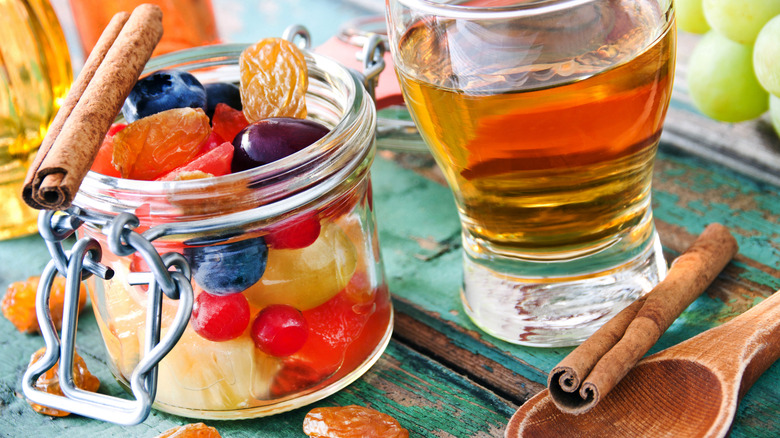Tutti Frutti: The Old School Ingredient You Could Add To Just About Anything
Exactly what "tutti frutti" might be, depends on who you ask. There will be those of us who might know tutti frutti as the small, chunks of candied fruit which have been used to add pops of color to baked goods like cakes, cookies, and ice cream. The Indian version of tutti-frutti is made with unripe, green papaya which has been chopped, blanched, and then cooked in sugar syrup before it is colored, per Instructables. The term has also been used to describe the mixed-fruit flavor used in children's sweets and ice cream, per Atlas Obscura.
But tutti frutti which means "all fruits" in Italian, can also be a boozy combination of fruit, sugar, and brandy which was kept in jars in many homes across the country from the late 19th century until the Prohibition in the 1920s (via Atlas Obscura), when it became illegal to make, transport, and sell liquor of any kind, per History.
Tutti fruitti was popular in the late 19th century
Atlas Obscura describes tutti frutti as a way of preserving fruit so it might be enjoyed any time of the year. To make the treat, a cook simply had to make a proportional mix of sugar and good brandy, then add whatever fruits were available or on hand, ensuring that the chunks or pieces were covered by the boozy liquid. When it was ready, you could then take what you needed to use or consume as you saw fit. During the olden days, tutti frutti was "a way of using up every single bit of food that you have," says food historian Joyce White, and it was so versatile it could be used to top ice creams and fill pies. In some cases, the fruit could even be used as a side for meat dishes.
While the practice of making tutti frutti might have declined in popularity — and was nearly eradicated thanks to Prohibition, a form of tutti frutti exists in kitchens today in a version The New York Times writer Melissa Clark once described simply as "boozy fruit." Her recipe instructs home cooks to "mix fruit and sugar with enough hard spirit to keep the fruit well soused, and let it sit." Clark even calls it "the simplest preserving method there is."
Similar versions of tutti fruitti exist in other food cultures
But the Italians don't have a monopoly on making boozy fruit. Clark writes in The New York Times that the Germans have a similar way of making their own fruit mix called rumtopf. The idea is to begin by mixing strawberries with sugar and rum in one large container, before adding other fruits as you come across them, until the entire fruit mixture is ready to be consumed, which is about three months after the rumtopf is first prepared. The rumtopf is usually left for six to twelve weeks in a cool, dark place until it is ready to be consumed, per The Spruce Eats.
If you want to give making tutti frutti or rumtopf a shot, just know that it can be difficult to mess up. As Amy Pennington agrees. "There's drying, salting, canning and using alcohol, which kills bacteria, meaning you don't need to futz around with creating an anaerobic environment," and that using alcohol was the "lowest rung of entry for beginning canning enthusiasts," per The New York Times.


